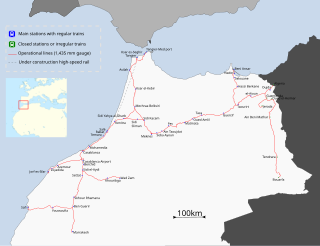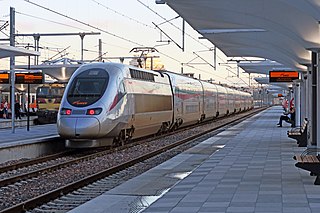
Citizens of Mauritania have various transportation methods. Railways and highways connect major cities in the country. Mauritania is a coastal country so there are many ports along its coast and there are a few big rivers that run through the country. Lastly, there are 26 airports spread out throughout the country.

Morocco, officially the Kingdom of Morocco, is the northwesternmost country in the Maghreb region of North Africa. It overlooks the Mediterranean Sea to the north and the Atlantic Ocean to the west, and has land borders with Algeria to the east, and the disputed territory of Western Sahara to the south. Morocco also claims the Spanish exclaves of Ceuta, Melilla and Peñón de Vélez de la Gomera, and several small Spanish-controlled islands off its coast. It spans an area of 446,550 km2 (172,410 sq mi) or 710,850 km2 (274,460 sq mi), with a population of roughly 37 million. Its official and predominant religion is Islam, and the official languages are Arabic and Berber; the Moroccan dialect of Arabic and French are also widely spoken. Moroccan identity and culture is a vibrant mix of Berber, Arab, and European cultures. Its capital is Rabat, while its largest city is Casablanca.

There are around 56,986 km (35,409 mi) of roads in Morocco. In addition to 1,808 km (1,123 mi) of highways.

The 'Alawi dynasty – also rendered in English as Alaouite, 'Alawid, or Alawite – is the current Moroccan royal family and reigning dynasty. They are an Arab sharifian dynasty and claim descent from the prophet Muhammad through one of his relatives.

Morocco's network of motorways is administered by the state-owned company Autoroutes du Maroc (ADM). It runs the network on a pay-per-use basis, with toll stations placed along its length. The general speed limit is 120 km/h.

The Casablanca–Rabat expressway, designated A1, was the first expressway to be built in Morocco, with construction starting in the 1970s. It was only completed in 1986 after a 7-year halt.

The Tangier American Legation is a building in the medina of Tangier, Morocco. The first American public property outside the United States, it commemorates the historic cultural and diplomatic relations between the United States and the Kingdom of Morocco. It is now officially called the Tangier American Legation Institute for Moroccan Studies, and is a cultural center, museum, and a research library, concentrating on Arabic language studies.

The Catholic Church in Morocco is part of the worldwide Catholic Church, under the spiritual leadership of the Pope in Rome. Catholics account for only about .07% of the overall population of over 31 million. The country is divided into two archdioceses; Rabat and Tangier.

ONCF is Morocco's national railway operator. ONCF is a state-owned company that is under the control of the Ministry of Equipment, Transport and Logistics and is responsible for all passenger and freight traffic on the national railway network. The company is also responsible for building and maintaining the rail infrastructure.

In Morocco, the 75 second-level administrative subdivisions are 13 prefectures and 62 provinces. They are subdivisions of the 12 regions of Morocco. Each prefecture or province is subdivided into arrondissements, municipalities or urban municipalities in other urban areas, and districts in rural areas. The districts are subdivided into rural municipalities. One prefecture (Casablanca) is also subdivided into préfectures d'arrondissements, similar to districts (cercles) except they are grouping a few arrondissements instead of rural municipalities.

The Cairo–Dakar Highway or TAH 1 is Trans-African Highway 1 in the transcontinental road network being developed by the United Nations Economic Commission for Africa (UNECA), the African Development Bank (ADB), and the African Union. The major part of the highway between Tripoli and Nouakchott has been constructed under a project of the Arab Maghreb Union.

Rail transport in Morocco is operated by the national railway operator ONCF. It was initially developed during the protectorate.

Al-Boraq is a 323-kilometre-long (201 mi) high-speed rail service between Casablanca and Tangier, operated by ONCF in Morocco. The first of its kind on the African continent, the high-speed service was inaugurated on 15 November 2018 by King Mohammed VI of Morocco following over a decade of planning and construction by Moroccan national railway company ONCF. It is the first phase of what is planned to eventually be a 1,500 kilometres (930 mi) high-speed rail network in Morocco. Al Boraq trains operate over a dedicated high speed line reaching speeds of up to 320 km/h on the 186 km sector between Tangier and Kenitra. From Kenitra trains operate over an upgraded mainline for the final 137 km through Morocco’s most populous corridor via Rabat to Casablanca.

The Casa-Voyageurs Railway Station is an ONCF station in the Belvedere neighborhood of Casablanca.

Tangier's economy is the third biggest of all Moroccan cities, after the economic capital Casablanca and the city of Fez. Tangier is Morocco's second most important industrial center after Casablanca. The industrial sectors are diversified: textile, chemical, mechanical, metallurgical and naval. Currently, the city has four industrial parks of which two have the status of free economic zone.

The N2 road is a national road in Morocco which connects Tangier in the northwest of the country with Oujda in the Northeast.
National Route 6 (N6) is a national highway of Morocco. It is one of the most important road networks linking the west of the country to the east, connecting the capital Rabat and Salé on the west coast to Maghnia, Algeria on the border. It passes through many of Morocco's major cities such as Oujda, Fes, Meknes and Khemisset. For much of the Fes- Rabat leg is runs parallel with the A2 Rabat–Fes expressway.
National Route 16 (N16) is a national highway of Morocco. It connects Tangier on the northwest coast of Morocco to Saidia on the northeast coast. It is an important highway running along the northern Middeteranean coast of the country. It passes through Tetouan, Al Houceima and other important cities.

Tanger-Tetouan-Al Hoceima is the northernmost of the twelve regions of Morocco. It covers an area of 15,090 km² and recorded a population of 3,556,729 in the 2014 Moroccan census. The capital of the region is Tangier.

The Embassy of the Philippines in Rabat is the diplomatic mission of the Republic of the Philippines to the Kingdom of Morocco. It is currently located in the Souissi neighborhood of southern Rabat, near the Finnish, Norwegian and Russian embassies. Although the current embassy dates from 2019, the Philippines maintained a previous resident embassy in Morocco until 1986, and again from 1990 to 1993.




















